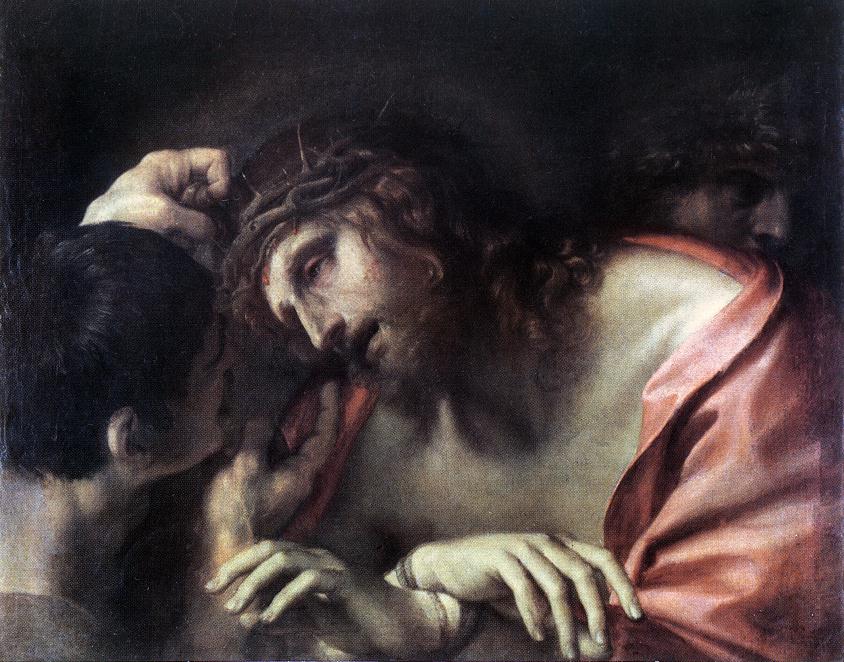
At this time of the year, many Christian traditions observe the season of Lent, the tradition of commemorating and meditating on the final stages of his earthly ministry, leading up to his crucifixion and eventual resurrection.
The “suffering Jesus” image can conjure up a lot of baggage for a lot of folks. This is where the uniquely Swedenborgian interpretation of the symbolism of the Christ narrative becomes incredibly helpful.
Swedenborgian-ism has a very positive Christology, or concept of Christ, theologically. And it’s very unique. So for just a moment, regardless of your personal beliefs, I invite you into a thought experiment: Imagine the whole story. With all of its bloody and gruesome elements. And now remove yourself from any cultural conditioning that views the suffering of Christ as a punishment for human sin. Or an act of vicarious sacrifice. Or a story you have to believe in to be saved from God. There is no room for any of that in Swedenborg’s Christology. God is love, God does not punish or judge or cause bad things to happen. View the story as a story about your inner self.
Swedenborg believed that every single element of the narrative of the Gospels has a direct correspondence to our own inner spiritual path.
“Because God came down, and because He is the design , there was no other way for him to become an actual human being than to be conceived, to be carried in the womb, to be born, to be brought up, and to acquire more and more knowledge so as to become intelligent and wise.
Therefore in his human manifestation he was an infant like any infant, a child like any child, and so on with just one difference: he completed the process more quickly, more fully, and more perfectly than the rest of us do.”
-True Christianity §89 (1)
Before I go more about how this story profoundly and intimately relates to our own inner being and our relationship, and eventual union, with the Divine, I should give a little bit of an overview about Swedenborg’s Christology and how it differs from others…
I already mentioned he did not believe in vicarious atonement, that Jesus suffered as a sacrifice for our sins. He also did not believe that a belief in Jesus is necessary to undergo regeneration. Most importantly, he believed in and explained that there is an inner meaning to the story, that it is corresponential and highly symbolic of our own inner life.
And while that’s where the meat is, he also believed that there was in fact a metaphysical reality to the Christ story (as opposed to pure myth, like the earth being created in seven days or Noah parting the sea…)
To Swedenborg, Jesus Christ functions as a balance-bringer. He believed that to be in true spiritual freedom, we need a framework that enables us to choose love and wisdom and integrate them into our lives (aka regeneration). And E.S. believed that there was just so much systemic meanness and falsity in the world, that the balance became out of whack… So Jesus fills two roles: he is a kind of avatar of love and truth who restores a kind of balance. Secondly, he is an embodiment of the union of the human with the divine
Another important and unique concept in Swedenborg’s theology is the “dual nature” of Christ. Neither Mary nor Jesus were born “perfect”. And that’s the whole point. As Jesus goes through life, he struggles A LOT because the process of Jesus of Nazareth becoming “the Lord” is a story of gradual self-realization. There’s the divine element within him, and the human element. And just like with everyone else, there are times when those imperfect human attributes of self-interest, egoism, anger, prejudice clash with the divine attributes of unconditional love and transcendent wisdom…
“The Lord endured the most grievous and terrible temptations, which are but little treated of in the literal sense of the Word, but much in the internal sense. The Lord fought from Divine Love towards the whole human race, and his love was the salvation of the human race. He combated from His own power, and alone became Justice and Merit, through temptations and victories.. Through temptations, the Lord united the Divine Itself which was in Him from conception, to His Human, and made it Divine; as He makes a us spiritual through temptations. The temptations of the Lord in the end were attended with despair.
Through the temptations admitted against Himself, the Lord subjugated the hells, and reduced all things in them and in the heavens to order, and at the same time glorified His Human. He admitted temptations from hell against Himself.
The Lord could not be tempted as to the Divine, because the hells cannot assault the Divine; wherefore He assumed from the mother such a Human as could be tempted. Through temptations and victories He expelled everything he inherited from the mother, and put off the Human from her, until at length He was no longer her son.
Jehovah, who was in Him from conception, appeared to be absent in His temptations. This was the state of His humiliation. His last temptation and victory, by which He fully subjugated the hells, and made His Human Divine, was in Gethsemane and on the cross.”
-New Jerusalem §201 (2)
So the whole story is the story of Jesus struggling between those two, and constantly being tempted to give into the hellish voices in his head. There is a DARK SIDE to Jesus. And as the story goes, he lives a life of kindness and healing and sharing of that transcendent wisdom. And what happens? He goes through pretty much the worst experience a human could have. He is betrayed, humiliated, tortured, and murdered. Publicly, as his fellow humans look on…
And throughout the entire experience, Jesus MAINTAINS his choosing of love and truth even at the face of the most horrible aspects of this human experience on such gruesome display. He is FULLY IMMERSED in the darkest side of being. “Father, forgive them, for they do not know what they are doing.” (Luke 23:34) Jesus goes so far as to go through the experience of feeling like God was completely absent. Existential despair… “My god, my god why have you forsaken me?!” (Matthew 24:46)
This is some profound imagery. And it’s why, to me personally, the story of Jesus is the ULTIMATE story of the ultimate human potential. We can choose to look at the Christ narrative as an ideal, namely, the consistent choosing of the Divine (aka love and truth) AMID the reality of humans choosing to be horrible to each other, to the point of actual regeneration and angelification, a transcendence of the human. A “divining” of the human.
Rudolf Steiner puts it beautifully:
“Only after the Mystery of Golgotha did it become possible to objectively experience Christ as that element enabling man to unite with the divine essence. The mystery disciples and their followers could say, ‘Outside my own being is a god who pours his essence into me.’ Or else they could say, ‘When I strengthen my inner being, I learn to know God in the depths of my own soul.’
Today, however, each human being can say, ‘The love that passes over into other souls and into other beings cannot be found outside my own being; it can be found only by continuing along the paths of my own soul.’
When we immerse ourselves lovingly into other beings, our souls remain the same; man remains human even when he goes beyond himself and discovers Christ within him. That He can be thus found was made possible by the Mystery of Golgotha…
We then have the mystical experience of feeling that a higher human essence lives in us, an essence that enwraps us in the same element that bears the soul from life to life, from incarnation to incarnation.
This is the mystical experience of Christ, which we can have only through a training in love.” (3)
The story of Jesus is not a story of punishment or sacrifice, it’s THE STORY of OUR inner awakening of the Christ within. The human having become a vessel, through free choice amid trial, of love and wisdom to the point of mystical union. It is the story of us. Swedenborg’s view of the Christ story, including its dark elements, can be a story of great comfort, which is exactly what it was meant to be. It enables us to look at the dark side of our earthly experience, and realize that EVEN GOD went through hell. Jesus experienced it both physically and psychologically, and yet he succeeded at manifesting love and truth.
The season of Lent can be a season of reflection about the dark side of Jesus, and a reminder that even in our darkest experiences of the ugliness of human life, we have an ally, an example, and a comforter in Christ, whose journey of God-realization is the story of our angelhood.
(1) Swedenborg, Emanuel. True Christianity. Translated by Jonathan S. Rose. West Chester, PA: Swedenborg Foundation, 2010.
(2) Swedenborg, Emanuel. New Jerusalem. Translated by George F. Dole. West Chester: Swedenborg Foundation, 2016.
(3) Steiner, Rudolf. “Jesus and Christ” – Lecture in Hamburg, November 15, 1913. Rudolf Steiner Archive. https://rsarchive.org/Lectures/JesChr_index.html. Accessed 3/4/2023

Rev. Thom Muller is pastor at the Swedenborgian Society of the East Bay at Hillside, an Urban Sanctuary, in El Cerrito, CA, as well as senior editor of Our Daily Bread. His passions include the intersection of spirituality and psychology, interfaith theology, and the Western esoteric tradition. A native of Germany, Rev. Muller was ordained into the ministry of the Swedenborgian Church of North America in 2016, upon receiving his theological education at Bryn Athyn College of the New Church and the Center for Swedenborgian Studies and Pacific School of Religion at the Graduate Theological Union in Berkeley.